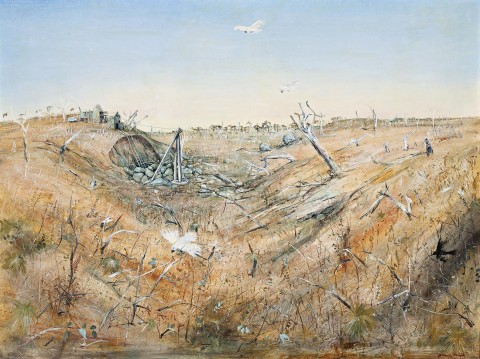THE OLD MINE, c.1951
ARTHUR BOYD
oil and tempera on composition board
91.0 x 121.0 cm
signed lower right: Arthur Boyd
Private collection
Sotheby’s, Melbourne, 30 April 1995, lot 118
Private collection, United Kingdom
‘Record Price Paid for McCubbin’, Sydney Morning Herald, Sydney, 1 May 1995, p. 3
Malsen, G., ‘The Return of the Collectors’, Sydney Morning Herald, Sydney, 2 May 1995, p. 15
Old mining country (near Bendigo), 1951, oil, tempera on composition board, 81.5 x 108.5 cm, in the collection of the National Gallery of Australia, Canberra, in Pearce, B., Arthur Boyd Retrospective, Art Gallery of New South Wales, Sydney, 1993, p. 85 (illus.)
The Old Mine, c.1951, belongs to the revelatory extended sequence of paintings by Arthur Boyd inspired by a month’s residency in Victoria’s Wimmera region in the autumn of 1950. Stilled and haunting, set beneath a vast and glaring sky, these images stand in stark contrast to the red-hot paintings of Australia’s interior created earlier by Russell Drysdale, and Boyd’s future brother-in-law Sidney Nolan. Rather, the Wimmera was close enough to Melbourne, Sydney and Canberra for its particular sense of country to be part of the lived sensibility of these otherwise metropolitan populations; and through them, Boyd ‘was showing Australians where they lived, mapping it, writing it home with his brush’.1
Born into a family of artists, Arthur Boyd became a master in a variety of media, including painting, drawing, printmaking, ceramics and ceramic sculpture. Although his imagery was populated by all forms of humanity and beasts – often imagined – Boyd’s great and enduring fascination was with landscape dating from his earliest years painting in Rosebud alongside his artist grandfather. Widely read and deeply thoughtful, Boyd was a seemingly quiet man who nonetheless displayed a steely resolve when it came to his art. On a visit to Melbourne in the autumn of 1950, Betty Bennett, a friend of Boyd’s wife Yvonne, invited the family to stay at her house in Horsham with her husband, the schoolteacher and poet Jack Stevenson. Yvonne immediately accepted, and piled the children into the car for the long journey. Somewhat wisely, Arthur followed soon after having taken time to ‘garner necessary art supplies. He puttered up, separately and quietly, a day or so later in the increasingly decrepit Dodge, its doors now tied up with wool-baling twine’.2
Boyd had already started experimenting with the centuries-old technique of tempera, a mixture of egg yolk, oil, water and pigment, which results in a matt, smooth surface. Extremely quick-drying, ‘the egg tempera … gave a new translucency to (Boyd’s) paintings of the late 1940s’,3 and by the time of the Wimmera trip, he was well versed in its use, and was able to harness tempera’s unique qualities for the resultant paintings, capturing in particular the baleful white light of the sky, the spiked thistles, stunted trees and the sharp stubble of the wheat. In The Old Mine, for example, the ramshackle machinery which originally scarred the gully has now become part of the landscape it inhabits, precariously perched on the edge of a dry and eroded creek bed. It seems destined to tumble into its own quarried hole, a cycle of bust and renewal that the environmentalist Boyd would no doubt have been happy to convey.
As the weeks in Horsham progressed, he set a steady routine of painting by day, bringing works back for critique by Yvonne and the others each evening. Subsequent to his return home, Boyd exhibited the ‘Wimmera’ paintings singly and in groups in Sydney, Melbourne and Adelaide where, as one critic wrote, ‘the artist’s parched landscapes echo the spirit of the countryside’.4 Ultimately, the paintings of this period established Arthur Boyd as one of the most important painters of his generation and led directly to his selection to represent Australia in the country’s inaugural presentation at the Venice Biennale of 1958, at which he showed a group of Wimmera paintings alongside works by the late Arthur Streeton. Such imagery would have been a revelation to European audiences, their first painterly encounter with these ‘more intimate aspects of the Australian landscape’.5
1. Bungey, D., Arthur Boyd: a life, Allen and Unwin, Sydney, 2007, p. 248
2. op cit., p. 243
3. Pearce, B., Arthur Boyd: retrospective, Beagle Press, Sydney, 1993, p. 19
4. “The Age” Art Critic, ‘New Approach by Arthur Boyd’, Age, Melbourne, 18 September 1951, p. 2
5. Campbell, R., ‘Arthur Boyd (1920 - )’, Australia: Paintings by Arthur Streeton and Arthur Boyd, XXIX Biennale, Venice, 1958, unpaginated
ANDREW GAYNOR
